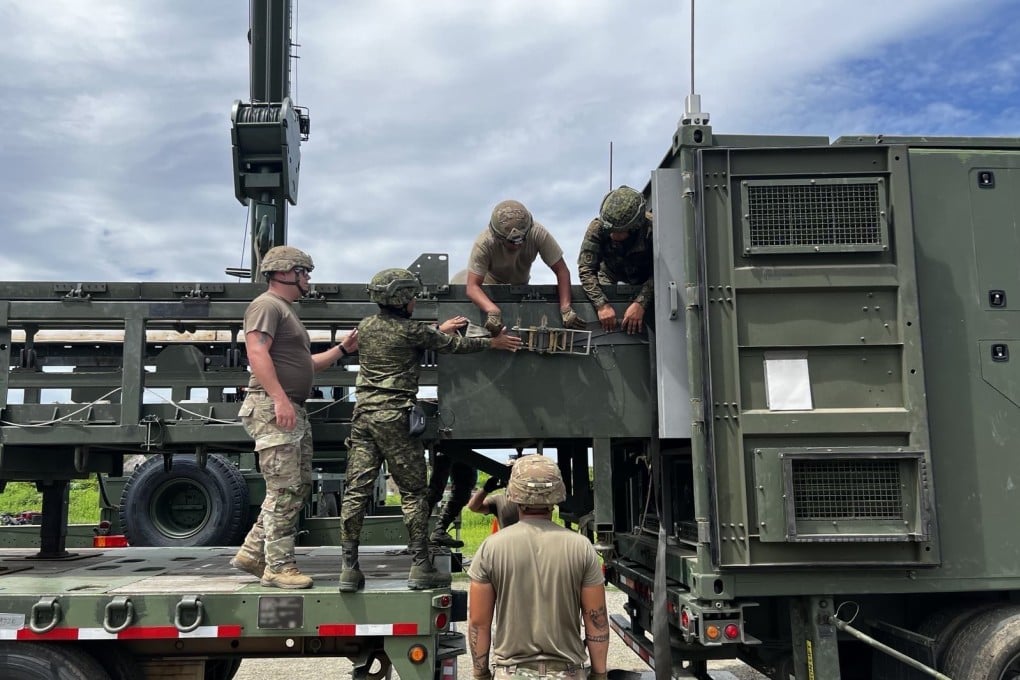Analyzing The US Typhon Missile System's Role In The South China Sea Dispute

Table of Contents
The Strategic Implications of a Hypothetical US Typhon Missile System in the South China Sea
Enhanced Deterrence and Power Projection
The deployment of a long-range, high-precision missile system like the hypothetical US Typhon Missile System could dramatically alter the strategic landscape.
- Increased range and accuracy: A system with extended range and pinpoint accuracy could deter aggressive actions by claimant states, potentially discouraging island building, militarization of features, or other provocative maneuvers. This increased range could cover a vast area of the South China Sea, significantly enhancing US reach and response capabilities.
- Multi-target strike capability: The ability to strike multiple targets simultaneously would minimize response time and limit the effectiveness of any retaliatory measures. This swift, decisive action capability could act as a significant deterrent.
- Power projection: The very presence of such a system would project US military power, reinforcing alliances with regional partners like Japan, the Philippines, and Vietnam, and potentially discouraging escalation by China or other claimant states.
- Preemptive strikes (ethical and legal considerations): The potential for preemptive strikes raises crucial ethical and legal questions. International law and the UN Charter generally prohibit the use of force except in self-defense or with Security Council authorization. The deployment of a system capable of preemptive strikes necessitates careful consideration of these limitations and potential legal ramifications.
Impact on Regional Stability and the Arms Race
Introducing a powerful new missile system into the South China Sea carries significant risks to regional stability.
- Arms race escalation: The deployment of the US Typhon Missile System (or a comparable system) would likely trigger an escalation of the regional arms race. China and other claimant states might accelerate their own military modernization programs, developing countermeasures or expanding their own arsenals.
- Increased risk of miscalculation and accidental conflict: The heightened military presence and increased capabilities increase the risk of miscalculation and accidental conflict. A minor incident could quickly escalate into a major confrontation.
- Destabilization of the regional balance of power: The introduction of such a significant military asset could further destabilize the already delicate regional balance of power, leading to increased tensions and mistrust.
- International law and treaties: International law and treaties, such as the UN Convention on the Law of the Sea (UNCLOS), play a crucial role in mitigating escalation. However, the effectiveness of these legal frameworks depends on the willingness of all parties to abide by them.
Analyzing the Potential Deployment Scenarios and Challenges
Logistical and Infrastructure Considerations
Deploying a system like the hypothetical US Typhon Missile System presents considerable logistical and infrastructural challenges.
- Base locations and supply lines: Identifying suitable base locations and establishing secure supply lines would be critical. This would necessitate agreements with regional allies and careful consideration of potential vulnerabilities.
- Integration with existing US military infrastructure: Seamless integration with existing US military infrastructure in the region, including communication networks and intelligence gathering capabilities, is crucial for effective operation.
- Vulnerabilities of deployment sites: Deployment sites would be potential targets for counterattacks, requiring robust defensive measures and contingency planning.
Political and Diplomatic Ramifications
The political and diplomatic repercussions of deploying such a system would be substantial.
- Reactions from China and other claimant states: The deployment would almost certainly provoke strong negative reactions from China and other claimant states, potentially leading to increased rhetoric, diplomatic protests, or even military posturing.
- Potential for diplomatic tensions and sanctions: Tensions could escalate, potentially resulting in diplomatic sanctions or other retaliatory measures.
- Impact on US relationships with regional allies and partners: The deployment's impact on the US's relationships with regional allies and partners would need careful consideration. Some might welcome the enhanced security, while others might express concerns about escalating tensions.
- Role of ASEAN: The Association of Southeast Asian Nations (ASEAN) plays a significant role in regional diplomacy. Its ability to mediate the dispute and manage the fallout from such a deployment is crucial.
Alternative Approaches and De-escalation Strategies
Military solutions are not the only path to resolving the South China Sea dispute.
Diplomacy and Negotiation
Diplomatic efforts remain essential for addressing the underlying territorial disputes.
- Importance of diplomatic efforts: Prioritizing diplomatic efforts to resolve territorial claims through negotiation and compromise is crucial to prevent further conflict.
- Role of international courts and arbitration: Utilizing international courts and arbitration mechanisms, such as those provided under UNCLOS, can help provide legally binding solutions.
- Peaceful solutions: Exploring peaceful solutions through multilateral dialogues and negotiations is fundamental to de-escalating tensions and creating a more stable region.
Confidence-Building Measures
Confidence-building measures can help reduce mistrust and prevent accidental conflict.
- Joint military exercises and information sharing: Joint military exercises and information sharing can foster transparency and reduce misunderstandings.
- Establishing communication channels: Establishing clear communication channels to prevent misinterpretations and manage crises is vital.
- Mechanisms to de-escalate tensions: Implementing mechanisms to de-escalate tensions and prevent accidental conflict are essential to maintain stability.
Conclusion
The potential deployment of a hypothetical US Typhon Missile System (or a relevant existing system) in the South China Sea presents a complex strategic challenge. While enhancing US deterrence and power projection capabilities, it also risks escalating the arms race and destabilizing the region. A balanced approach that combines military readiness with robust diplomatic engagement is essential. Prioritizing alternative conflict resolution strategies, alongside robust communication and confidence-building measures, is key to preventing unintended escalation and promoting a peaceful resolution to the South China Sea dispute. Further research and analysis into the implications of such a deployment, specifically considering the role of the US Typhon Missile System (or a relevant existing system) in the South China Sea, are critical for navigating this volatile geopolitical landscape. Strategic planning involving the US Typhon Missile System (or a relevant existing system) must include thorough risk assessment and proactive diplomacy to mitigate the risk of unintended consequences.

Featured Posts
-
 Twilight Romance Exploring The Love Lives Of Robert Pattinson And Other Stars
May 20, 2025
Twilight Romance Exploring The Love Lives Of Robert Pattinson And Other Stars
May 20, 2025 -
 Nyt Mini Crossword Solution March 16 2025
May 20, 2025
Nyt Mini Crossword Solution March 16 2025
May 20, 2025 -
 Salon International Du Livre D Abidjan Lancement De La 15eme Edition
May 20, 2025
Salon International Du Livre D Abidjan Lancement De La 15eme Edition
May 20, 2025 -
 The Enduring Appeal Of Agatha Christies Hercule Poirot
May 20, 2025
The Enduring Appeal Of Agatha Christies Hercule Poirot
May 20, 2025 -
 Biografiya Mirry Andreevoy Put K Uspekhu V Mire Bolshogo Tennisa
May 20, 2025
Biografiya Mirry Andreevoy Put K Uspekhu V Mire Bolshogo Tennisa
May 20, 2025
